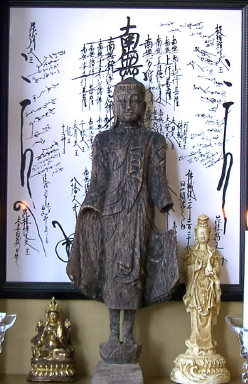On Gaining an Immediate Reward for Faith in the Three Treasures
![]()
 | Yasunoko was very happy and announced the imperial decree to Shima no oomi, who, in great joy, commissioned Ikeba no atae Hita to carve three bodhisattvas. They were consecrated in a hall at Toyura to inspire awe and reverence in the people. However, Lord Mononobe no yuge no Motiya no omuraji address the empress, saying, "NO Buddha images should be kept in this country. They must be thrown away." Hearing this, the empress call Lord Ysaunoko no muraji, saying, "Hide these Buddha images without delay." Thereupon he had Hita no atae hide them among rice sheaves. Lord Yuge no omuraji eventually burned the hall and threw the remaining images into the canal at Naniwa. He rebuked Yasunoko, saying, "The cause of our present disaster lies in keeping pagan images sent from a neighboring country. Give them up and throw them into the current which flows toward Korea." ("Pagan images" mean "Buddha images.") Yasunoko firmly refused. Yuge no omuraji, deranged and rebellious, looked for an opportunity for treason, but heaven disliked him and earth heatedhim. He was at last overthrown in the reign of Emporer Yomei, and the Buddhist images were brought into the open to be kept for posterity. The image of Amida is now enshrined at Hiso-dera at Yoshino. |